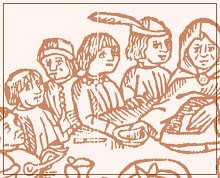The most interesting one was this:
Hans Memling. Man of Sorrows in Virgin’s Arms. Flemish, 1475-79. Oil and gold leaf on wood panelling. At the National Gallery of Victoria (Melbourne).
It’s quite small – less in height than the length of my forearm – so despite the vivid colours, no one else was much interested in it. But the scarlet particularly is very brilliant (less so in the image here than in real life), and the expressions of the faces – especially those of the heads scattered around the background – are very vivid and characterful. Mary and Jesus are a little more conventional, and less colourful, save for the blood.
What struck me about this painting was, firstly, that it’s an arma Christi, a convention (or genre, really) that I thought was rather outdated by this time (though it’s way out of my field, so I could be very wrong). I was also curious to see that the rather brief information on it didn’t mention that, or give any explanation of the visual conventions to which Memling appeals.
The second curious thing is that, among the traditional objects of torture – the whipping-post, the flail, the spear, the hammer and nails – are positioned the heads, hands and feet of the multitude who jeered him. The hands particularly are interesting, positioned variously to pinch, punch, slap, whip and jeer (one seems to be making a rude gesture?), as if to cover all the insults that a hand might inflict on a man. The fragmented bodies of the crowd become weapons against Christ, and therefore for him, extensions (by implication) of his own body – literally his arma. And the vivid personalisation of every face (from many different professions and social ranks, given their clothing) implicates and involves them as individuals, not as tokens. I don’t know how common this sort of image was, but I haven’t seen it before. Is anyone else familiar with this as a tradition?
All in all, it seems to me that Memling was using more recent techniques – the vivid colours, the realistic portraiture – to reinvigorate much older images – not only the arma Christi itself, but the fascination with and veneration of the bodily fluids. Christ catches and cups the blood running down his side, drawing attention to it and perhaps beginning the process of converting it to a relic. The blood on his head and shoulder is echoed and reinforced both by the duplication of the colour in the costumes of the crowd, and by the pure, clear tears running down Mary’s cheeks.
If this is deliberate (and if I’m not misreading completely), perhaps Memling is trying to draw his viewers into the picture, to show real “modern” people as the tormentors of a traditionally recognisable Christ, to convey that very personal “we are his tormentors, we daily wound him with our sins” message.
Incidentally, in hunting the web for the image (before I thought to go to the NGV’s website) I found this:
Same artist, same period, but apparently much less expensive production – the duller colours may be due to less careful preservation, but the gold leaf background is lacking. Interestingly, Mary’s headscarf is much less ornate, and Jesus’ hair less beautifully brushed. The combination of these factors would lead me to guess that this one came first, and the NGV version was, perhaps, commissioned by a richer patron after he/she saw the Capilla Real painting. And that might have been a good reason to change those two religious-looking folk in the top left corner to something a little less politically suggestive.
Also, this one has a rooster (on top of the whipping post, where there’s another head in the NGV painting), presumably he who crew three times; which makes this version more of a retelling of the Passion than a focus on the arma.
------
[1] There was one curious carving of St John the Baptist, which I puzzled over for a while – I couldn’t work out whether he was meant to be wearing the skin of a goat or a dragon. I remembered lately it’s meant to be a camel skin he wears, but this one had dragon scales, goat hooves and a reptilian but goat-shaped head. Apparently very odd depictions of unfamiliar animals aren’t unique to the illustrators of bestiaries!




.jpg)


No comments:
Post a Comment